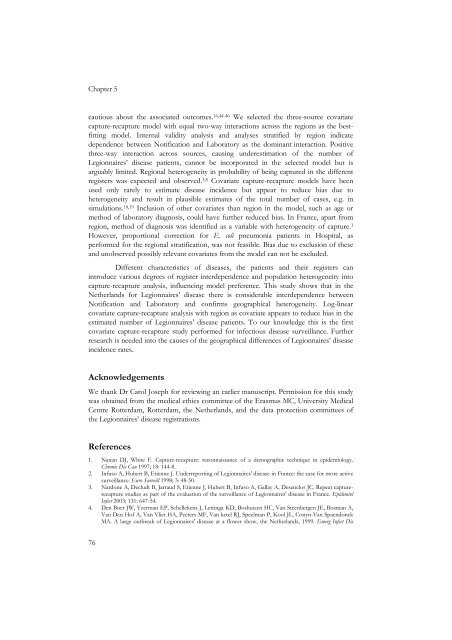Rob van Hest Capture-recapture Methods in Surveillance - RePub ...
Rob van Hest Capture-recapture Methods in Surveillance - RePub ...
Rob van Hest Capture-recapture Methods in Surveillance - RePub ...
You also want an ePaper? Increase the reach of your titles
YUMPU automatically turns print PDFs into web optimized ePapers that Google loves.
Chapter 5<br />
cautious about the associated outcomes. 16,44-46 We selected the three-source covariate<br />
capture-<strong>recapture</strong> model with equal two-way <strong>in</strong>teractions across the regions as the bestfitt<strong>in</strong>g<br />
model. Internal validity analysis and analyses stratified by region <strong>in</strong>dicate<br />
dependence between Notification and Laboratory as the dom<strong>in</strong>ant <strong>in</strong>teraction. Positive<br />
three-way <strong>in</strong>teraction across sources, caus<strong>in</strong>g underestimation of the number of<br />
Legionnaires’ disease patients, cannot be <strong>in</strong>corporated <strong>in</strong> the selected model but is<br />
arguably limited. Regional heterogeneity <strong>in</strong> probability of be<strong>in</strong>g captured <strong>in</strong> the different<br />
registers was expected and observed. 3,8 Covariate capture-<strong>recapture</strong> models have been<br />
used only rarely to estimate disease <strong>in</strong>cidence but appear to reduce bias due to<br />
heterogeneity and result <strong>in</strong> plausible estimates of the total number of cases, e.g. <strong>in</strong><br />
simulations. 18,19 Inclusion of other covariates than region <strong>in</strong> the model, such as age or<br />
method of laboratory diagnosis, could have further reduced bias. In France, apart from<br />
region, method of diagnosis was identified as a variable with heterogeneity of capture. 3<br />
However, proportional correction for E. coli pneumonia patients <strong>in</strong> Hospital, as<br />
performed for the regional stratification, was not feasible. Bias due to exclusion of these<br />
and unobserved possibly rele<strong>van</strong>t covariates from the model can not be excluded.<br />
Different characteristics of diseases, the patients and their registers can<br />
<strong>in</strong>troduce various degrees of register <strong>in</strong>terdependence and population heterogeneity <strong>in</strong>to<br />
capture-<strong>recapture</strong> analysis, <strong>in</strong>fluenc<strong>in</strong>g model preference. This study shows that <strong>in</strong> the<br />
Netherlands for Legionnaires’ disease there is considerable <strong>in</strong>terdependence between<br />
Notification and Laboratory and confirms geographical heterogeneity. Log-l<strong>in</strong>ear<br />
covariate capture-<strong>recapture</strong> analysis with region as covariate appears to reduce bias <strong>in</strong> the<br />
estimated number of Legionnaires’ disease patients. To our knowledge this is the first<br />
covariate capture-<strong>recapture</strong> study performed for <strong>in</strong>fectious disease surveillance. Further<br />
research is needed <strong>in</strong>to the causes of the geographical differences of Legionnaires’ disease<br />
<strong>in</strong>cidence rates.<br />
Acknowledgements<br />
We thank Dr Carol Joseph for review<strong>in</strong>g an earlier manuscript. Permission for this study<br />
was obta<strong>in</strong>ed from the medical ethics committee of the Erasmus MC, University Medical<br />
Centre Rotterdam, Rotterdam, the Netherlands, and the data protection committees of<br />
the Legionnaires’ disease registrations.<br />
References<br />
1. Nanan DJ, White F. <strong>Capture</strong>-<strong>recapture</strong>: reconnaissance of a demographic technique <strong>in</strong> epidemiology.<br />
Chronic Dis Can 1997; 18: 144-8.<br />
2. Infuso A, Hubert B, Etienne J. Underreport<strong>in</strong>g of Legionnaires' disease <strong>in</strong> France: the case for more active<br />
surveillance. Euro Surveill 1998; 3: 48-50.<br />
3. Nardone A, Decludt B, Jarraud S, Etienne J, Hubert B, Infuso A, Gallay A, Desenclos JC. Repeat capture<strong>recapture</strong><br />
studies as part of the evaluation of the surveillance of Legionnaires' disease <strong>in</strong> France. Epidemiol<br />
Infect 2003; 131: 647-54.<br />
4. Den Boer JW, Yzerman EP, Schellekens J, Lett<strong>in</strong>ga KD, Boshuizen HC, Van Steenbergen JE, Bosman A,<br />
Van Den Hof A, Van Vliet HA, Peeters MF, Van ketel RJ, Speelman P, Kool JL, Conyn-Van Spaendonck<br />
MA. A large outbreak of Legionnaires' disease at a flower show, the Netherlands, 1999. Emerg Infect Dis<br />
76

















